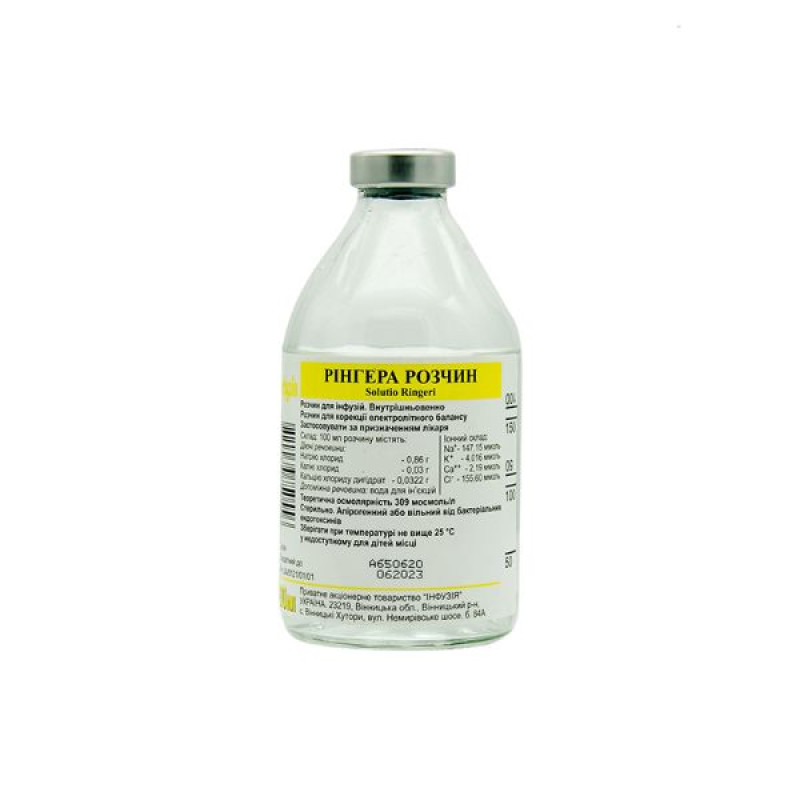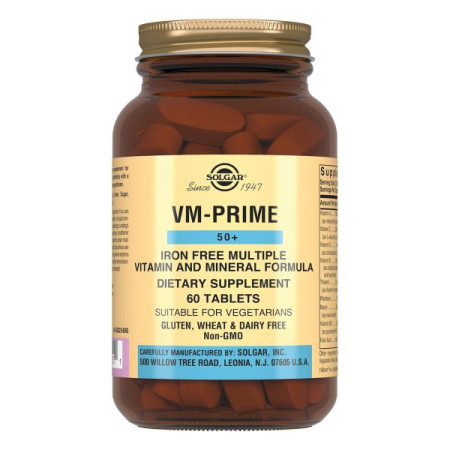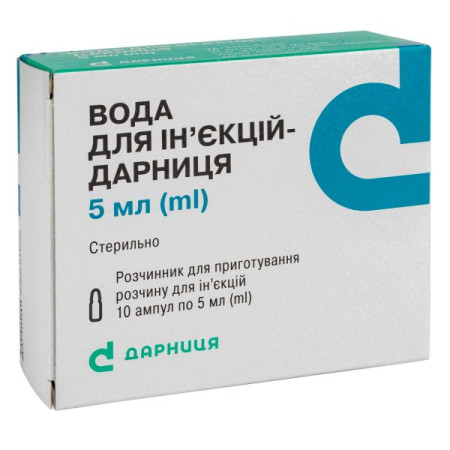Ringer's solution for infusions bottle 200 ml

Translation of the instructions can be
RINGER'S SOLUTION solution for infusionInstruction
For medical use of the medicinal product
Ringer's solution
(Ringer solution)
Composition:
Active ingredients: sodium chloride, potassium chloride, calcium chloride dihydrate;
100 ml of solution contain sodium chloride - 0.86 g; potassium chloride - 0.03 g; calcium chloride dihydrate - 0.0322 g;
excipient: water for injections.
Ionic composition per 1000 ml of the drug: Na + - 147.15 mmol; K + - 4.016 mmol; Ca ++ - 2.19 mmol; Cl - - 155.60 mmol.
Dosage form.
Solution for infusion.
Main physicochemical properties: transparent colorless liquid; theoretical osmolarity - 309 mosmol/l; pH 5.0-7.5.
Pharmacotherapeutic group.
Solutions for intravenous administration. Solutions used to correct electrolyte imbalances. ATS code B05B B01.
Pharmacological properties.
Pharmacodynamics.
Ringer's solution is a source of water and electrolytes. It can induce diuresis depending on the patient's condition.
Sodium, the main cation of extracellular fluid, is involved primarily in the control of water distribution, water balance, and osmotic pressure of body fluids. Sodium is also associated with chlorine and bicarbonate in the regulation of acid-base balance of body fluids.
Potassium, the main cation of intracellular fluid, participates in carbohydrate utilization and protein synthesis, and is needed for the regulation of nerve conduction and muscle contraction, especially of the heart.
Chloride, the major extracellular anion, is closely related to sodium metabolism, and changes in the body's acid-base balance are accompanied by changes in chloride concentration. Infusion of large amounts of chloride ions can cause loss of bicarbonate ions, leading to acidosis. For this reason, Ringer's solution is buffered with lactate or acetate.
Calcium, an important cation that ensures the formation of bones and teeth (in the form of calcium phosphate and calcium carbonate). In its ionized form, calcium is needed for the functional mechanism of blood clotting, normal heart function, and the regulation of neuromuscular excitability.
Pharmacokinetics.
Na + and Cl - ions, introduced with Ringer's solution, have the same pharmacokinetics as those that came with food. They are freely distributed in all organs, tissues and intercellular spaces and are excreted during glomerular filtration in the kidneys. In the tubules, significant reabsorption of Na + and Cl - ions occurs, mainly in the loop of Henle and the distal tubule, including the mechanism of blocking by loop and thiazide diuretics, respectively.
Potassium ions (K+) are freely filtered in the glomerulus, but are almost completely reabsorbed in the proximal tubules, and only 10% of the filtered K+ ions are excreted. Secretion in the distal tubules and collecting tubules can greatly increase K+ elimination. The kidneys have a limited capacity to store K+. Therefore, when the Na+ concentration in the distal tubules is high, K+ loss can be significant and hypokalemia can develop. This explains the presence of K+ in Ringer's solution.
Calcium ion (Ca++) homeostasis is well controlled by hormones and rarely requires clinical intervention with intravenous infusion of solution.
Clinical characteristics.
Indication.
It is used for hypovolemia and extracellular dehydration due to prolonged vomiting, diarrhea, significant burns, frostbite, peritonitis, severe infectious diseases, shock, collapse; during surgery and in the postoperative period.
Used for diluting concentrated electrolyte solutions.
Contraindication.
hypernatremia; hyperkalemia; hypercalcemia; hyperhydration; metabolic alkalosis; decompensated heart failure; oliguria and anuria; acute renal failure; pulmonary edema; cerebral edema; hypercoagulation; thrombophlebitis.Interaction with other drugs and other types of interactions.
Sodium retention in the body may increase with the simultaneous use of the following drugs: nonsteroidal anti-inflammatory drugs, androgens, anabolic hormones, estrogens, corticotropin, mineralocorticoids, vasodilators or ganglioblockers.
When used with potassium-sparing diuretics, ACE inhibitors and potassium preparations, the risk of developing hyperkalemia increases.
In combination with cardiac glycosides, the likelihood of their toxic effects increases.
Application features.
During prolonged parenteral therapy, it is necessary to determine laboratory parameters and give a clinical assessment of the patient's condition to monitor electrolyte concentrations and water-electrolyte balance every 6 hours (depending on the infusion rate).
The use of intravenous solutions can cause fluid and/or solute overload, hyperhydration, congestion, and pulmonary edema. The risk of dilution is inversely proportional to electrolyte concentration. The risk of solution overload, which causes congestion with peripheral edema and pulmonary edema, is directly proportional to electrolyte concentration.
Due to the content of sodium ions, the solution should be used with caution in patients with renal and cardiovascular insufficiency, with congestive heart failure, especially in the postoperative period or in elderly patients, as well as in patients with clinical conditions accompanied by sodium retention and edema.
The potassium content requires caution when using the solution in patients with heart disease, hyperkalemia, severe renal failure, and clinical conditions accompanied by potassium retention in the body.
Potassium should be administered under ECG monitoring, especially in patients receiving digitalis. Serum calcium levels do not always reflect tissue calcium levels.
In patients with reduced renal function, administration of the solution may lead to sodium or potassium retention.
The presence of calcium ions requires caution when administered simultaneously with blood products due to the likelihood of coagulation.
Parenteral calcium should be administered with special care to patients receiving cardiac glycosides.
This solution is intended for intravenous administration using sterile equipment. It is recommended to change the intravenous line at least every 24 hours.
The solution should only be used when it is clear and the bottle is airtight.
The physician should also consider the possibility of adverse reactions to drugs used concurrently with Ringer's solution.
If an adverse reaction occurs, the infusion should be stopped, the patient's condition assessed, and appropriate therapeutic measures instituted.
Use during pregnancy or breastfeeding.
No studies have been conducted on the use of Ringer's solution in pregnant women.
It is not known whether this drug is excreted in human milk. Because most drugs are excreted in human milk, caution should be exercised when Ringer's solution is administered to a nursing woman.
The ability to influence the reaction speed when driving vehicles or other mechanisms.
Data are missing due to the use of the drug exclusively in a hospital setting.
Method of administration and doses.
The mixture is intended for intravenous use only.
The dose is prescribed by a doctor and depends on the patient's age, body weight, clinical condition and laboratory parameters.
The usual dose for an adult is up to 1-2 liters per day; the maximum dose depends on the state of water and electrolyte balance, cardiovascular system and kidneys.
The infusion rate for adults is 60-80 drops/minute or jet.
The solution should be prescribed based on the estimated maintenance or replacement fluid requirements for each patient.
Parenteral products should be inspected visually for particulate matter and discoloration prior to administration.
Children.
No studies have been conducted on the use of Ringer's solution in children.
Overdose.
Administration of too much solution may lead to fluid and electrolyte imbalance (hypervolemia, hypernatremia, hypercalcemia, hyperchloremia) and acid-base imbalance. Treatment is symptomatic.
Adverse reactions.
Electrolyte metabolism disorders (potassium, calcium, sodium, chlorine), chloride acidosis, and hyperhydration may occur.
In case of adverse reactions, the solution should be stopped, the patient's condition assessed and assistance provided.
Expiration date.
3 years.
Storage conditions.
Store at a temperature not exceeding 25°C out of the reach of children.
Incompatibility.
To reduce the risk of possible incompatibility arising from mixing this solution with other prescribed additives, the final infusion solution should be inspected for turbidity or precipitation immediately after mixing, prior to use, and periodically during use.
Packaging.
200 ml and 400 ml bottles.
Vacation category.
According to the recipe.
Producer.
Private Joint Stock Company "Infusion".
Location of production and its address of place of business.
Ukraine, 21034 Vinnytsia, Voloshkova St., 55
or
Ukraine, 23219, Vinnytsia region, Vinnytsia district, Vinnyts'ki Khutory village, Nemyrivske highway st., 84A.
Applicant.
Private Joint Stock Company "Infusion".
Location of the applicant and/or the applicant's representative.
Ukraine, 04073, Kyiv, Moskovsky Prospect, 21-a.
There are no reviews for this product.
There are no reviews for this product, be the first to leave your review.
No questions about this product, be the first and ask your question.









